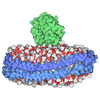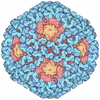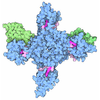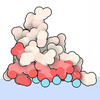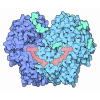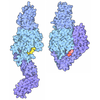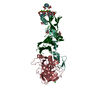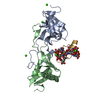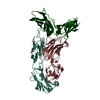[English] 日本語
 Yorodumi
Yorodumi- PDB-9p0x: Nanodisc-embedded human TF/FVIIa/XK1 in complex with 10H10 Fab (n... -
+ Open data
Open data
- Basic information
Basic information
| Entry | Database: PDB / ID: 9p0x | ||||||||||||||||||
|---|---|---|---|---|---|---|---|---|---|---|---|---|---|---|---|---|---|---|---|
| Title | Nanodisc-embedded human TF/FVIIa/XK1 in complex with 10H10 Fab (nanodisc-subtracted) | ||||||||||||||||||
 Components Components |
| ||||||||||||||||||
 Keywords Keywords | BLOOD CLOTTING / complex / nanodisc | ||||||||||||||||||
| Function / homology |  Function and homology information Function and homology informationactivation of plasma proteins involved in acute inflammatory response / activation of blood coagulation via clotting cascade / coagulation factor VIIa / response to Thyroid stimulating hormone / response to astaxanthin / response to thyrotropin-releasing hormone / response to 2,3,7,8-tetrachlorodibenzodioxine / response to carbon dioxide / response to genistein / serine-type peptidase complex ...activation of plasma proteins involved in acute inflammatory response / activation of blood coagulation via clotting cascade / coagulation factor VIIa / response to Thyroid stimulating hormone / response to astaxanthin / response to thyrotropin-releasing hormone / response to 2,3,7,8-tetrachlorodibenzodioxine / response to carbon dioxide / response to genistein / serine-type peptidase complex / response to vitamin K / coagulation factor Xa / positive regulation of platelet-derived growth factor receptor signaling pathway / positive regulation of leukocyte chemotaxis / response to thyroxine / NGF-stimulated transcription / Defective factor IX causes thrombophilia / Defective cofactor function of FVIIIa variant / Defective F9 variant does not activate FX / response to cholesterol / cytokine receptor activity / response to growth hormone / positive regulation of positive chemotaxis / Extrinsic Pathway of Fibrin Clot Formation / endopeptidase inhibitor activity / cellular response to steroid hormone stimulus / negative regulation of blood coagulation / positive regulation of endothelial cell apoptotic process / positive regulation of blood coagulation / carbohydrate transmembrane transporter activity / animal organ regeneration / maltose binding / positive regulation of TOR signaling / maltose transport / maltodextrin transmembrane transport / Transport of gamma-carboxylated protein precursors from the endoplasmic reticulum to the Golgi apparatus / Gamma-carboxylation of protein precursors / Common Pathway of Fibrin Clot Formation / Removal of aminoterminal propeptides from gamma-carboxylated proteins / side of membrane / ATP-binding cassette (ABC) transporter complex, substrate-binding subunit-containing / Intrinsic Pathway of Fibrin Clot Formation / positive regulation of endothelial cell proliferation / serine-type peptidase activity / BMAL1:CLOCK,NPAS2 activates circadian expression / positive regulation of interleukin-8 production / serine-type endopeptidase inhibitor activity / circadian rhythm / protein processing / phospholipid binding / caveola / Golgi lumen / response to estrogen / cytokine-mediated signaling pathway / positive regulation of angiogenesis / blood coagulation / response to estradiol / : / outer membrane-bounded periplasmic space / protease binding / vesicle / response to hypoxia / positive regulation of cell migration / endoplasmic reticulum lumen / signaling receptor binding / external side of plasma membrane / serine-type endopeptidase activity / calcium ion binding / positive regulation of gene expression / cell surface / endoplasmic reticulum / proteolysis / extracellular space / extracellular region / membrane / plasma membrane Similarity search - Function | ||||||||||||||||||
| Biological species |  Homo sapiens (human) Homo sapiens (human)  | ||||||||||||||||||
| Method | ELECTRON MICROSCOPY / single particle reconstruction / cryo EM / Resolution: 3.7 Å | ||||||||||||||||||
 Authors Authors | Photenhauer, A.L. / Sedzro, J.C. / Ohi, M.D. / Morrissey, J.H. | ||||||||||||||||||
| Funding support |  United States, 5items United States, 5items
| ||||||||||||||||||
 Citation Citation |  Journal: Blood / Year: 2025 Journal: Blood / Year: 2025Title: Cryo-EM structure of the tissue factor/factor VIIa complex with a factor X mimetic reveals a novel allosteric mechanism. Authors: Josepha C Sedzro / Amanda L Photenhauer / Fabienne Birkle / Katarina Meze / Alex Mortenson / Cade Duckworth / Po-Chao Wen / Sarah Kearns / Michael A Cianfrocco / Emad Tajkhorshid / Melanie D ...Authors: Josepha C Sedzro / Amanda L Photenhauer / Fabienne Birkle / Katarina Meze / Alex Mortenson / Cade Duckworth / Po-Chao Wen / Sarah Kearns / Michael A Cianfrocco / Emad Tajkhorshid / Melanie D Ohi / James H Morrissey /  Abstract: Blood clotting is triggered in hemostasis and thrombosis when the membrane-bound tissue factor (TF)/factor VIIa (FVIIa) complex activates factor X (FX). There are no structures of TF/FVIIa on ...Blood clotting is triggered in hemostasis and thrombosis when the membrane-bound tissue factor (TF)/factor VIIa (FVIIa) complex activates factor X (FX). There are no structures of TF/FVIIa on membranes, with or without FX. Using cryo-EM to address this gap, we assembled TF/FVIIa complexes on nanoscale membrane bilayers (nanodiscs), bound to XK1 and an antibody fragment. XK1 is a FX mimetic whose protease domain is replaced by the first Kunitz-type (K1) domain of tissue factor pathway inhibitor, while 10H10 is a non-inhibitory, anti-TF antibody. We determined a cryo-EM structure of a TF/FVIIa/XK1/10H10/nanodisc complex with a resolution of 3.7 Å, allowing us to model all the protein backbones. TF/FVIIa extends perpendicularly from the membrane, interacting with a "handle shaped" XK1 at two locations: the K1 domain docks into FVIIa's active site, while the γ-carboxyglutamate-rich (GLA) domain binds to TF's substrate-binding exosite. The FX and FVIIa GLA domains also contact each other and the membrane surface. Except for a minor contact between the first epidermal growth factor (EGF)-like domain of XK1 and TF, the rest of the FX light chain does not interact with TF/FVIIa. The structure reveals a previously unrecognized, membrane-dependent allosteric activation mechanism between FVIIa and TF where a serine-rich loop in TF that partially obscures the TF exosite must undergo a shift to allow access of the FX GLA domain to its final binding location on the membrane-bound TF/FVIIa complex. This mechanism also provides a novel explanation for the otherwise puzzling phenomenon of TF encryption/decryption on cell surfaces. | ||||||||||||||||||
| History |
|
- Structure visualization
Structure visualization
| Structure viewer | Molecule:  Molmil Molmil Jmol/JSmol Jmol/JSmol |
|---|
- Downloads & links
Downloads & links
- Download
Download
| PDBx/mmCIF format |  9p0x.cif.gz 9p0x.cif.gz | 289.7 KB | Display |  PDBx/mmCIF format PDBx/mmCIF format |
|---|---|---|---|---|
| PDB format |  pdb9p0x.ent.gz pdb9p0x.ent.gz | 188.3 KB | Display |  PDB format PDB format |
| PDBx/mmJSON format |  9p0x.json.gz 9p0x.json.gz | Tree view |  PDBx/mmJSON format PDBx/mmJSON format | |
| Others |  Other downloads Other downloads |
-Validation report
| Summary document |  9p0x_validation.pdf.gz 9p0x_validation.pdf.gz | 1.5 MB | Display |  wwPDB validaton report wwPDB validaton report |
|---|---|---|---|---|
| Full document |  9p0x_full_validation.pdf.gz 9p0x_full_validation.pdf.gz | 1.5 MB | Display | |
| Data in XML |  9p0x_validation.xml.gz 9p0x_validation.xml.gz | 56.2 KB | Display | |
| Data in CIF |  9p0x_validation.cif.gz 9p0x_validation.cif.gz | 83.1 KB | Display | |
| Arichive directory |  https://data.pdbj.org/pub/pdb/validation_reports/p0/9p0x https://data.pdbj.org/pub/pdb/validation_reports/p0/9p0x ftp://data.pdbj.org/pub/pdb/validation_reports/p0/9p0x ftp://data.pdbj.org/pub/pdb/validation_reports/p0/9p0x | HTTPS FTP |
-Related structure data
| Related structure data |  71090MC M: map data used to model this data C: citing same article ( |
|---|---|
| Similar structure data | Similarity search - Function & homology  F&H Search F&H Search |
- Links
Links
- Assembly
Assembly
| Deposited unit | 
|
|---|---|
| 1 |
|
- Components
Components
-Protein , 5 types, 5 molecules VXSTK
| #1: Protein | Mass: 16359.772 Da / Num. of mol.: 1 Source method: isolated from a genetically manipulated source Source: (gene. exp.)  Homo sapiens (human) / Gene: F7 / Cell line (production host): HEK293 / Production host: Homo sapiens (human) / Gene: F7 / Cell line (production host): HEK293 / Production host:  Homo sapiens (human) / References: UniProt: P08709 Homo sapiens (human) / References: UniProt: P08709 |
|---|---|
| #2: Protein | Mass: 15309.423 Da / Num. of mol.: 1 Source method: isolated from a genetically manipulated source Source: (gene. exp.)  Homo sapiens (human) / Gene: F10 / Plasmid: pcDNA3.1(+) / Cell line (production host): HEK293 / Production host: Homo sapiens (human) / Gene: F10 / Plasmid: pcDNA3.1(+) / Cell line (production host): HEK293 / Production host:  Homo sapiens (human) / References: UniProt: P00742 Homo sapiens (human) / References: UniProt: P00742 |
| #3: Protein | Mass: 28103.256 Da / Num. of mol.: 1 Source method: isolated from a genetically manipulated source Source: (gene. exp.)  Homo sapiens (human) / Gene: F7 / Cell line (production host): HEK293 / Production host: Homo sapiens (human) / Gene: F7 / Cell line (production host): HEK293 / Production host:  Homo sapiens (human) / References: UniProt: P08709, coagulation factor VIIa Homo sapiens (human) / References: UniProt: P08709, coagulation factor VIIa |
| #4: Protein | Mass: 67828.523 Da / Num. of mol.: 1 Source method: isolated from a genetically manipulated source Source: (gene. exp.)  Homo sapiens (human), (gene. exp.) Homo sapiens (human), (gene. exp.)  Gene: F3, malE, Z5632, ECs5017 / Plasmid: pET-26b(+) / Production host:  |
| #5: Protein | Mass: 7979.198 Da / Num. of mol.: 1 Source method: isolated from a genetically manipulated source Source: (gene. exp.)  Homo sapiens (human) / Gene: TFPI, LACI, TFPI1 / Plasmid: pcDNA3.1(+) / Cell line (production host): HEK293 / Production host: Homo sapiens (human) / Gene: TFPI, LACI, TFPI1 / Plasmid: pcDNA3.1(+) / Cell line (production host): HEK293 / Production host:  Homo sapiens (human) / References: UniProt: P10646 Homo sapiens (human) / References: UniProt: P10646 |
-Antibody , 2 types, 2 molecules HL
| #6: Antibody | Mass: 23569.252 Da / Num. of mol.: 1 / Source method: isolated from a natural source / Source: (natural)  |
|---|---|
| #7: Antibody | Mass: 24196.709 Da / Num. of mol.: 1 / Source method: isolated from a natural source / Source: (natural)  |
-Sugars , 2 types, 2 molecules 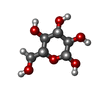
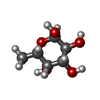

| #10: Sugar | ChemComp-BGC / |
|---|---|
| #11: Sugar | ChemComp-FUC / |
-Non-polymers , 2 types, 16 molecules 


| #8: Chemical | ChemComp-MG / #9: Chemical | ChemComp-CA / |
|---|
-Details
| Has ligand of interest | N |
|---|---|
| Has protein modification | Y |
-Experimental details
-Experiment
| Experiment | Method: ELECTRON MICROSCOPY |
|---|---|
| EM experiment | Aggregation state: PARTICLE / 3D reconstruction method: single particle reconstruction |
- Sample preparation
Sample preparation
| Component |
| ||||||||||||||||||||||||||||||||||||||||||
|---|---|---|---|---|---|---|---|---|---|---|---|---|---|---|---|---|---|---|---|---|---|---|---|---|---|---|---|---|---|---|---|---|---|---|---|---|---|---|---|---|---|---|---|
| Source (natural) |
| ||||||||||||||||||||||||||||||||||||||||||
| Source (recombinant) |
| ||||||||||||||||||||||||||||||||||||||||||
| Buffer solution | pH: 7.4 | ||||||||||||||||||||||||||||||||||||||||||
| Specimen | Embedding applied: NO / Shadowing applied: NO / Staining applied: NO / Vitrification applied: YES | ||||||||||||||||||||||||||||||||||||||||||
| Specimen support | Grid material: COPPER / Grid mesh size: 200 divisions/in. / Grid type: Quantifoil R2/2 | ||||||||||||||||||||||||||||||||||||||||||
| Vitrification | Instrument: FEI VITROBOT MARK IV / Cryogen name: ETHANE / Humidity: 100 % / Chamber temperature: 277 K |
- Electron microscopy imaging
Electron microscopy imaging
| Experimental equipment |  Model: Titan Krios / Image courtesy: FEI Company |
|---|---|
| Microscopy | Model: TFS KRIOS |
| Electron gun | Electron source:  FIELD EMISSION GUN / Accelerating voltage: 300 kV / Illumination mode: FLOOD BEAM FIELD EMISSION GUN / Accelerating voltage: 300 kV / Illumination mode: FLOOD BEAM |
| Electron lens | Mode: BRIGHT FIELD / Nominal magnification: 105000 X / Nominal defocus max: 2500 nm / Nominal defocus min: 1000 nm |
| Image recording | Electron dose: 50 e/Å2 / Film or detector model: GATAN K3 (6k x 4k) / Num. of grids imaged: 1 / Num. of real images: 7132 |
| EM imaging optics | Energyfilter slit width: 20 eV |
- Processing
Processing
| EM software |
| ||||||||||||||||||||||||||||||||||||||||||||||||||||||||||||||||||||||||||||||||||||||||||||||||||||||||
|---|---|---|---|---|---|---|---|---|---|---|---|---|---|---|---|---|---|---|---|---|---|---|---|---|---|---|---|---|---|---|---|---|---|---|---|---|---|---|---|---|---|---|---|---|---|---|---|---|---|---|---|---|---|---|---|---|---|---|---|---|---|---|---|---|---|---|---|---|---|---|---|---|---|---|---|---|---|---|---|---|---|---|---|---|---|---|---|---|---|---|---|---|---|---|---|---|---|---|---|---|---|---|---|---|---|
| CTF correction | Type: NONE | ||||||||||||||||||||||||||||||||||||||||||||||||||||||||||||||||||||||||||||||||||||||||||||||||||||||||
| Particle selection | Num. of particles selected: 2862371 | ||||||||||||||||||||||||||||||||||||||||||||||||||||||||||||||||||||||||||||||||||||||||||||||||||||||||
| Symmetry | Point symmetry: C1 (asymmetric) | ||||||||||||||||||||||||||||||||||||||||||||||||||||||||||||||||||||||||||||||||||||||||||||||||||||||||
| 3D reconstruction | Resolution: 3.7 Å / Resolution method: FSC 0.143 CUT-OFF / Num. of particles: 20107 / Symmetry type: POINT | ||||||||||||||||||||||||||||||||||||||||||||||||||||||||||||||||||||||||||||||||||||||||||||||||||||||||
| Atomic model building | Protocol: FLEXIBLE FIT / Space: REAL / Target criteria: cross-correlation Details: Crystal structures were rigid-body fit into the density map and model optimization was then carried out with Phenix real-space refine. Manual refinement in Coot was performed to ensure that ...Details: Crystal structures were rigid-body fit into the density map and model optimization was then carried out with Phenix real-space refine. Manual refinement in Coot was performed to ensure that the backbone traces followed the density in regions where the map was high enough resolution to trace the backbone. Secondary structure restraints were used to ensure that alpha-helices and beta-sheets did not deviate far from their expected geometry. A final check of MolProbity and cross correlation was done to ensure model quality. | ||||||||||||||||||||||||||||||||||||||||||||||||||||||||||||||||||||||||||||||||||||||||||||||||||||||||
| Atomic model building | 3D fitting-ID: 1 / Source name: PDB / Type: experimental model
| ||||||||||||||||||||||||||||||||||||||||||||||||||||||||||||||||||||||||||||||||||||||||||||||||||||||||
| Refinement | Cross valid method: NONE Stereochemistry target values: GeoStd + Monomer Library + CDL v1.2 | ||||||||||||||||||||||||||||||||||||||||||||||||||||||||||||||||||||||||||||||||||||||||||||||||||||||||
| Displacement parameters | Biso mean: 95.04 Å2 | ||||||||||||||||||||||||||||||||||||||||||||||||||||||||||||||||||||||||||||||||||||||||||||||||||||||||
| Refine LS restraints |
|
 Movie
Movie Controller
Controller





 PDBj
PDBj
